Client Context
The client, Bonduelle Fresh Americas (Jackson, Georgia) plant, manufactures/processes salad and bistro bowls for major retailers/supermarkets across the United States. Their products focus on fresh and sanitary individual packs that are healthy and convenient. The Jackson plant is used to distribute products within the southeast region, especially to major big box retailers such as Publix, Walmart, Whole Foods, and Trader Joe’s. Our client contact is a process improvement engineer who works on improving the operational efficiencies of the plant. The two systems that we studied include parts breakdown replacement process and production/shipping process.
Machinery Part Replacement Process
- A part breaks down --> A mechanic looks for a spare part in the inventory room --> If the spare part is not present or it is difficult to locate, our client contact must find a way to ship the part in as soon as possible to minimize downtime and the loss of potential revenue.
Production/Shipping Process
- Orders are received from retailers, such as Publix and Walmart --> Raw materials are processed within salad and bistro lines --> Orders are shipped on the same day.
Project Objective
Our objectives include lowering Bonduelle’s part replacement costs, predicting future consumer demand, and increasing the plant’s production capacity. We have identified two main opportunities, which include decreasing operational costs and increasing revenue. To decrease operational costs, we explored the client’s usage of expedited shipping. Currently, the client utilizes expedited shipping to bring in necessary machinery parts for operation if the parts are not in the inventory. The client currently spends about $60K for these services and our goal is to decrease this cost. To increase revenue, we determined that production capacity has not been meeting the demand levels because of a nonexistent worker scheduling model that would account for spikes in demand levels. Some days, there are not enough workers to properly meet all of the customer demand whereas on other days, the client schedules more workers than needed to meet the subsequent product demand. This has led to instances when orders remained unfulfilled, leaving about $2.5MM annually that the client could earn if they had optimal production levels.
Design Strategy
ABC Analysis Design
- Inventory Classification
Classified machinery parts using consumption frequencies and unit costs into three distinct categories, A, B, and C.
- Optimal Reorder Strategy
Determined the quantity that the client should order for each of the 1,800 parts in inventory and when they should place these orders to ensure that they do not have to use expedited shipping. Additionally, we quantified the amount of safety stock that the client should always have on-hand to avoid stock outs. We provided separate policies for parts in each category, and for inexpensive vs. expensive parts.
- Result Validation
Performed multiple simulations to validate the results of implementing the new reorder policies and quantified its impact by comparing its potential results to those of the client’s current reorder policy.
Demand Prediction Design
- ARIMA Model
Used 2019 to 2020 daily consumer order information to predict future demand. Considered seasonality, pricing, and daily patterns. The predicted demand values were validated with the actual values and had a MAPE accuracy of 83%.
- Labor Optimization Model
By using predicted demand values, labor headcount averages, and per-worker production capacity of both salad and bistro lines, we created a labor optimization model in Gurobi which allocates workers to shifts/days with high predicted consumer demands so that more orders can be fulfilled than those completed currently.
Deliverables
ABC Analysis Deliverables
- Excel file with reordering policies for 1800 parts that can be input into the JDE database that the client currently uses to manage inventory.
- Two Simio files that can be used to quantify the impact of the new reorder policies on expedited shipping fees and production throughput (the client can use these files in the future as well if they decide to make changes to the reorder policies).
ABC Recommendations
- Place parts in category “A” close to the entrance (first floor), those in category “B” close to the wall, and the ones in category “C” on the second floor of the inventory room.
- Input the reordering policies into JDE so that it can send out alerts to reorder the parts, which have inventory levels at or below their reorder points.
Demand Prediction Deliverables
- Consumer demand prediction (ARIMA R code).
- Labor Schedule Optimization Model (Gurobi code) and guidelines regarding the constraints and factors considered for this model.
Demand Prediction Recommendations
- Implement the ARIMA R code to predict future consumer demand.
- Assign some members of your team to determine the feasibility of the labor scheduling model and evaluate further labor standards and scheduling restrictions that might arise in the future.


